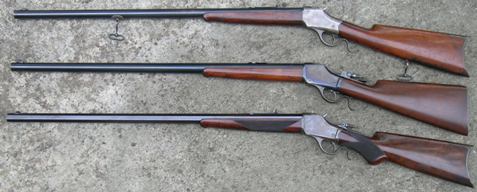December 6, 2020
 Offline
OfflineI have a high wall schuetzen with a mysterious stamping on the left side of the lower tang. Beside the assembly number and the XX wood upgrade is a large US stamp. The only reference I’ve come across that mentions this stamp is in John Campbells book “The Winchester single-shot Volume II”, and then the mention was very brief. The author was describing a rifle that was known as an International Match Rifle, but the description of that rifle was nothing like mine. Mine is a full-blown Schuetzen target rifle and matches the Cody letter to a T. Could there have been a US Schuetzen match team that competed internationally?
April 15, 2005
 Offline
OfflineWayne said
I have a high wall schuetzen with a mysterious stamping on the left side of the lower tang. Beside the assembly number and the XX wood upgrade is a large US stamp. The only reference I’ve come across that mentions this stamp is in John Campbells book “The Winchester single-shot Volume II”, and then the mention was very brief. The author was describing a rifle that was known as an International Match Rifle, but the description of that rifle was nothing like mine. Mine is a full-blown Schuetzen target rifle and matches the Cody letter to a T. Could there have been a US Schuetzen match team that competed internationally?
The “US” marking you found has nothing to do with who the rifle was built for. It is simply a part of the assembly markings.
Bert
WACA Historian & Board of Director Member #6571L

May 23, 2009
 Offline
OfflineAm I recalling correctly that such a marking is denoting the maker of the steel used?
Sincerely,
Maverick
![]()
WACA #8783 - Checkout my Reloading Tool Survey!
https://winchestercollector.org/forum/winchester-research-surveys/winchester-reloading-tool-survey/
April 15, 2005
 Offline
OfflineMaverick said
Am I recalling correctly that such a marking is denoting the maker of the steel used?Sincerely,
Maverick
No, you are not recalling it correctly. The steel makers markings are typically found stamped on the bottom of the barrel. To the very best of my knowledge, no steel makers markings are found on the forged milled receiver frames or associated parts like a lower tang. Keep in mind that the lower tang started out as a block of steel that Winchester subsequently milled, drilled, and finished.
Bert
WACA Historian & Board of Director Member #6571L



 Log In
Log In







